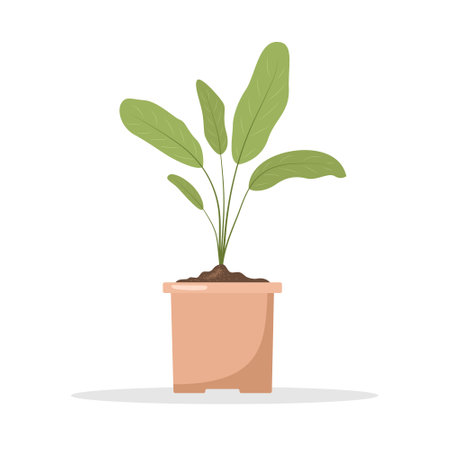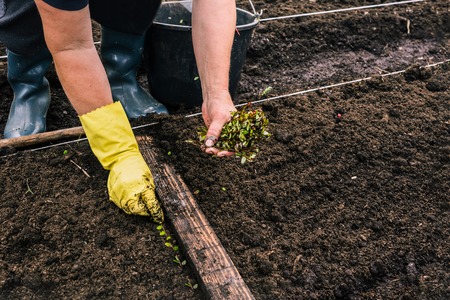1. Getting Started: Choosing the Right Containers and Soil
Starting your culinary herb journey in the UK is a bit like preparing a family picnic: it’s all about selecting the right kit and making sure everyone is comfy—especially your herbs! Whether you’re working with a cosy balcony, a sunlit windowsill, or a classic British garden, choosing the best pots and compost will set you up for success. When it comes to containers, terracotta pots are a timeless choice that let roots breathe and help prevent waterlogging—a real bonus during those drizzly British summers. If you’re growing indoors or have limited space, lightweight plastic or ceramic planters with good drainage work wonders and can be easily moved to chase the sun. For families with little hands eager to help, why not try colourful window boxes or recycled tubs? It adds a splash of fun and creativity to your plant collection.
Now, onto soil—think of it as the welcoming bed where your herbs will rest and grow. Culinary herbs thrive in free-draining compost; look out for peat-free multipurpose composts mixed with a handful of horticultural grit or perlite to ensure roots don’t get soggy. The unique UK climate means we need to balance moisture retention with drainage, especially for Mediterranean favourites like rosemary and thyme. For those who fancy experimenting, try making your own blend by mixing garden compost with sand and leaf mould—a hands-on way to connect children with the cycles of nature. Remember, happy roots mean flavourful harvests, so take your time choosing containers and compost that suit both your home and the ever-changing British weather.
2. Selecting Herbs for the British Kitchen
The joy of growing culinary herbs in containers begins with choosing the right varieties that will flourish in the unique climate of the UK and delight every member of your family. From hearty classics to delicate favourites, British gardens have long embraced a range of aromatic herbs that add both flavour and fragrance to home-cooked meals. Below, you’ll find an introduction to some popular and traditional culinary herbs, along with helpful tips for selecting varieties your loved ones will enjoy.
Popular Culinary Herbs That Thrive in the UK
| Herb | Flavour Profile | Family-Friendly Uses |
|---|---|---|
| Basil | Sweet, slightly peppery | Perfect for pasta sauces, pizzas, and salads—children love its fresh taste! |
| Chives | Mild onion-like flavour | Adds a gentle kick to sandwiches, scrambled eggs, or baked potatoes—easy for little hands to snip! |
| Coriander (Cilantro) | Citrusy, fresh | Great for curries and salsas; introduce gradually as its flavour can be divisive among kids. |
| Mint | Cool, refreshing | Lovely in drinks, desserts, or peas—grows vigorously and is fun for children to harvest. |
| Parsley | Mild, grassy | A staple garnish and salad herb; flat-leaf varieties often preferred by British cooks. |
| Rosemary | Pine-like, robust | Lends depth to roast meats and vegetables; encourages children’s senses with its aromatic leaves. |
| Sage | Earthy, savoury | Traditional in stuffing and sausages—great for family Sunday roasts. |
| Thyme | Lemony, subtle | Blends beautifully into stews and soups; easy to grow on sunny windowsills. |
Tips for Choosing Family-Favourite Varieties
- Engage young gardeners: Let children choose a few herbs they are curious about. Try unusual varieties like chocolate mint or lemon thyme for extra excitement!
- Consider culinary traditions: Think about which dishes your family enjoys most—herbs like chervil or tarragon might suit French-inspired kitchens, while dill or fennel are perfect for fish-loving households.
- Select compact or dwarf varieties: These are ideal for container growing and make harvesting easier for little hands.
- Mix textures and scents: Combining soft-leaved basil with woody rosemary or fuzzy sage creates a sensory-rich mini garden that invites exploration.
The Magic of Growing Together
Selecting herbs as a family not only introduces children to new flavours but also sparks curiosity about where food comes from. Whether you’re nurturing tiny seedlings on the kitchen windowsill or arranging pots on the patio, each plant offers an opportunity to connect—with nature and with one another—as you watch your edible garden grow and thrive in the heart of your British home.

3. Planting and Sowing: Step-by-Step Guidance
Bringing your container herb garden to life is a hands-on adventure that’s both rewarding and wonderfully simple—especially when the little ones are eager to help! With just a few thoughtful steps, your kitchen windowsill or balcony can burst into fragrant, edible greenery that’s as pleasing to the eye as it is to the palate.
Choosing Your Seeds or Young Plants
Start by selecting herbs well-suited for British weather—basil, chives, mint, parsley, thyme, and rosemary are all splendid choices. Decide whether you’d like to sow seeds or buy young plug plants from your local garden centre. If you’re gardening with children, young plants offer instant gratification, while sowing seeds together lets you marvel at every stage of growth.
Sowing Seeds with Little Helpers
Fill your containers with peat-free multipurpose compost, leaving about an inch from the top. Sprinkle seeds thinly over the surface (think of scattering fairy dust!), then cover lightly with a thin layer of compost—no need to bury them too deep. Gently water using a fine rose on your watering can, so as not to wash away the seeds. Place the pots in a warm, bright spot—a sunny windowsill works wonders in springtime Britain. Encourage your child to check daily for signs of sprouting, turning waiting into a magical countdown.
Transplanting Young Herbs
If using young plants, ease them out of their nursery pots and tease apart any tangled roots. Dig a small hole in your container just big enough for the root ball and settle each plant in its new home. Pat down the compost around each herb and water them in well. Let children press the soil gently—like tucking in their green friends for a good night’s rest!
Arranging for Beauty and Bounty
Arrange taller herbs like rosemary or sage towards the back or centre of larger pots, with trailing varieties such as thyme or creeping oregano at the edges where they can spill gracefully over the sides. Mixing colours and textures creates a living tapestry that delights all senses—and makes snipping fresh herbs for dinner even more fun.
Top Tip: Group According to Needs
Cluster Mediterranean herbs (rosemary, thyme) together since they prefer drier soil, while parsley and basil enjoy more moisture. This keeps everyone happy and thriving—just like siblings sharing a space but respecting each other’s quirks!
With these easy-to-follow steps, even the smallest hands can take part in creating a thriving herb haven right outside your kitchen door. Happy planting!
4. Caring for Your Herb Containers Throughout the Seasons
Once your herbs are happily nestled in their containers, caring for them is like nurturing a growing friendship—one that changes with each season in the UK. Teaching children to look after these green companions can become a wonderful family ritual, connecting your household to nature’s cycles. Here’s how to keep your herb pots thriving all year round.
Watering: Dancing with the British Weather
The UK’s weather is famously changeable, and so your herbs’ thirst will vary too. In spring and summer, check pots every morning—perhaps as part of a morning routine with your little ones. If the top inch of soil feels dry, it’s time to water. Rainy days might mean you can skip watering altogether, so encourage children to be weather detectives! In autumn and winter, reduce watering; soggy roots dislike chilly weather even more than we do.
| Season | Watering Frequency | Child-Friendly Tip |
|---|---|---|
| Spring | Check every 1-2 days | Let kids poke soil with their finger to test dryness |
| Summer | Daily (sometimes twice on hot days) | Use a small watering can for easy pouring |
| Autumn | Every 3-4 days or after rainfall | Count raindrops together to see if watering is needed! |
| Winter | Weekly or less; only if dry indoors | Create a ‘herb hibernation’ chart to track moisture |
Feeding: Keeping Herbs Happy and Healthy
Potted herbs need nutrients because rain washes them away faster than in garden beds. From March to September, feed with a liquid seaweed fertiliser every few weeks—invite children to mix the ‘magic potion’ and pour it gently around the plants. After September, let herbs rest without extra feeding, mimicking nature’s quiet pause.
Simple Feeding Schedule:
- March–September: Feed fortnightly with diluted liquid feed.
- October–February: No feeding required.
Pruning: Snip and Grow Together
Regular picking not only encourages bushier growth but also provides a lovely opportunity for parent-child teamwork. Show children how to use child-safe scissors or pinch off sprigs above a leaf node. Herbs like basil and mint love frequent haircuts, while woody types like rosemary benefit from gentle shaping in late spring or early summer.
Pruning Tips by Herb Type:
- Basil, Mint, Parsley: Pinch back often; harvest leaves from the top.
- Thyme, Rosemary, Sage: Trim lightly after flowering; avoid cutting into old wood.
- Chives: Snip at the base; flowers are edible too!
Overwintering: Cosy Pots for Chilly Months
The UK’s winters can be damp and cold. Tender herbs like basil should come indoors before the first frost—make it a fun family migration! Hardier herbs such as rosemary and thyme can stay outside but appreciate a sheltered spot against a wall or wrapped in horticultural fleece. Encourage children to help tuck their plant friends in for winter rest.
Overwintering Checklist:
- Select indoor spots with good light for tender herbs (kitchen windowsills are perfect).
- Add mulch or straw around outdoor pots for insulation.
- Lessen watering but don’t let soil dry out completely.
- Cuddle pots together for warmth in exposed gardens or balconies.
Nurturing your herb containers through the changing seasons becomes more than just gardening—it’s an ongoing story you share with your children and your plants, one where everyone grows together under the ever-changing British skies.
5. Harvesting and Using Your Home-Grown Herbs
Tips for Harvesting Herbs at Their Peak
Harvesting your container-grown herbs at just the right moment ensures you capture the very best of their aroma and flavour. The ideal time is usually in the morning, once any dew has evaporated but before the midday sun grows too strong. Snip just above a leaf node with clean scissors or secateurs—this will encourage bushier growth and keep your plants thriving. Remember, never take more than a third of the plant at once; this gentle approach allows your herbs to recover and continue producing.
Inviting Children to Join the Herbal Adventure
Involve your little ones in the joy of harvesting by turning it into a sensory adventure. Encourage them to gently rub leaves between their fingers and describe the scents—minty, lemony, earthy, or spicy. Let them snip sprigs and gather leaves in their own little baskets. This hands-on experience not only strengthens family bonds but also helps children connect with nature, fostering curiosity and responsibility. You might even assign each child their own herb pot to nurture, harvest from, and care for.
Inspiring Ways to Use Fresh Herbs in British Cooking
Now comes the most rewarding part: bringing those vibrant flavours into your kitchen! Sprinkle freshly chopped parsley over classic fish pie or new potatoes for a burst of green freshness. Add mint to your peas or blend it into homemade sauces for roast lamb—a true British favourite. Chives can be snipped onto scrambled eggs for breakfast, while rosemary infuses roasted veg or Sunday chicken with comforting fragrance. For family fun, let children decorate pizzas with torn basil leaves or help whisk up herb butters to spread on crusty bread alongside soup.
Herb-Infused Family Moments
Cooking together with home-grown herbs turns everyday meals into meaningful family rituals. Invite children to taste-test and suggest which herbs might pair well with tonight’s dinner—a sprinkle here, a garnish there—and watch as their confidence in the kitchen blossoms like the plants on your windowsill.
Cherish Each Season’s Bounty
As the year unfolds, celebrate each season’s unique offerings by drying surplus herbs for winter stews or freezing them in ice cube trays with olive oil ready for quick use. In every pinch and sprinkle, you’ll find memories of muddy hands, laughter, and shared discovery—proof that growing culinary herbs is about so much more than just flavour.
6. Troubleshooting: Common Pests and Problems
Even the most lovingly nurtured container herb gardens in the UK can encounter a few bumps along the way. But don’t worry—many common issues can be solved naturally, sustainably, and with a gentle hand, so you and your green companions can continue to flourish together.
Spotting Trouble Early
Plants, much like children, often give us clues when something’s amiss. Yellowing leaves, wilting, or spots can signal a cry for help. Take time each day to check on your herbs; early detection makes solutions easier and keeps problems from spreading.
Aphids and Slugs: Tiny Invaders
Aphids love tender new growth, while slugs are notorious for their nocturnal feasts on soft leaves. Encourage natural predators such as ladybirds (ladybugs) and birds by making your garden welcoming with native flowers or small bird feeders. For slugs, try scattering crushed eggshells or using copper tape around pot rims—the sensation deters them without chemicals.
Mildew and Mould: When Dampness Lingers
The UK’s famously damp weather can sometimes lead to powdery mildew or mould. Ensure containers have good drainage holes, and avoid overcrowding—herbs need space to breathe just as we do. Water at the base of plants in the morning, so leaves dry quickly in daylight. If needed, spray with a homemade solution of water and a splash of milk or a pinch of baking soda.
Root Rot and Overwatering
Herbs dislike soggy feet! Always use pots with drainage holes and add gravel at the bottom if possible. Let soil dry slightly between waterings—poke your finger an inch into the compost; if it feels dry, it’s time to water. Remember, most culinary herbs prefer to be on the drier side.
Encouraging Resilience Naturally
Like guiding children through life’s challenges, fostering healthy herbs is about prevention and gentle guidance. Rotate pots occasionally for even sunlight, use peat-free compost for sustainability, and feed sparingly with organic fertiliser during growing season. Happy herbs are more resilient to pests and diseases—and will reward you with lush flavour for your kitchen adventures.
Cherishing Every Lesson
Every spotty leaf or nibbled stem is an opportunity to learn together. With patience and care rooted in nature-friendly practices, you’ll create a thriving oasis where both your family and your cherished herbs can grow strong—side by side.


